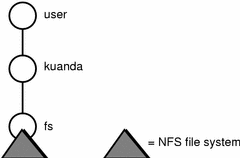FNS File System Namespace
Files may be named relative to users, hosts, organizations, and sites in FNS by appending the fs enterprise namespace identifier to the name of the object, and following this with the name of the file. For example, the file draft96 in the sales division's budget directory might be named org/sales/fs/budget/draft96.
The initial context is located under /xfn in the file system's root directory. Thus a user might view the file by typing
% more /xfn/org/sales/fs/budget/draft96 |
Existing applications can access this directory just as they would any other directory. Applications do not need to be modified in any way or use the XFN API.
NFS File Servers
NFS is Sun's distributed file system. The files associated with an object will generally reside on one or more remote NFS file servers. In the simplest case, the namespace identifier fs corresponds to the root of an exported NFS file system, as shown in Figure 22-4.
Figure 22-4 NFS File System--Simple Case

In contrast, an object's file system may be composed of multiple--and possibly overlapping--remote mounts, woven together into a "virtual" directory structure managed by FNS.
Figure 22-5 illustrates how this capability might be used to piece together an organization's file system from three separate file servers. The project directory, along with its lib subdirectory, resides on one file server, while the src subdirectory resides on another. Users and applications need not be aware of the use of multiple servers; they see a single, seamless namespace.
Figure 22-5 NFS File System--Multiple Servers

The Automounter
For efficiency, the automounter is used to mount FNS directories on demand. The default /etc/auto_master configuration file contains the line:
/xfn -xfn |
which tells the automounter that the FNS namespace is "mounted" under /xfn, as specified by XFN.
Since the automounter is used to mount directories named through FNS, the subdirectories of an FNS directory cannot be listed until they have been mounted. For example, suppose the file system of the sales organization is composed of multiple NFS file systems. The following ls command shows only two file systems that have been visited recently and are currently mounted:
% ls /xfn/org/sales/fs customers products |
To see the entire listing, use the fnlist command:
% fnlist org/sales/fs Listing org/sales/fs: products goals customers incentives |
- © 2010, Oracle Corporation and/or its affiliates
